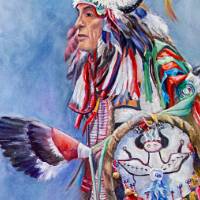'Infinity Cube' Subtractive Sculpting Activity | ArtPrize 2021
Welcome to ArtPrize 2021 at GVSU! We’re excited to host two large sculptures at two different locations on our Pew campus in downtown Grand Rapids; Jason Quigno's Infinity Cube, at L.V. Eberhard Center; and José Marcelino Valdez and Gerson Valdez-Cordòn's Mayan Stelae Of King K'ak' Tiliw Chan Topaat. at L. William Seidman Center. Both sculptures are located outdoors and are on view to the public during ArtPrize, September 16 - October 3, 2021.
In this lesson you’ll get a close look at both works of art, and we’ll take a deep dive into one of them; learning about and exploring the creative process of local artist Jason Quigno.

Jason Quigno with maquette of Infinity Cube at his studio Asinaabe Studios
Virtual Tour and Activity
1) View the Sculptures
Play this video (it doesn't have commentary) and ask students to look and think about what they see, students can respond in conversation or in writing.
- What do you see?
- What do you think this sculpture is made of?
- Does this sculpture remind you of anything?
- What questions do you have about this artwork?
2) Learn About the Sculptures
This video includes commentary. This time, listen and look to learn more about these sculptures.
3) Learn About Jason Quigno
Play this video of an interview with the artist Jason Quigno to learn more about his creative process and subtractive carving method.
4) Subtractive Carving Activity
Materials
- 6-sided sketch worksheet (included)
- Pencil
- Ivory bar soap (Ivory soap is softest. Other bar soaps may not be soft enough for younger students to carve)
- Carving tools
- Craft paper, newspaper, or paper towel to cover tables as a drop-cloth
Delivery (Carving Activity)
- Today we’re going to create a sculpture using a subtractive carving process.
- Subtractive sculpting involves the removal of material from a block – through cutting, chiseling, chipping, or scraping away.
- When artists carve stone, wood, or plaster they usually use a subtractive sculptural process.
- Subtractive sculpture is the oldest form of sculpture.
- Artists use positive and negative space to create shapes and forms in a subtractive sculpture.
- Space is the area above, below, between, within and around the main objects in a piece of art. Space is present in both 2D & 3D works of art.
- Positive Space = the shapes or forms (main objects) in an artwork.
- Negative Space = the space that surrounds the main objects. It is the empty or non-interesting space between and around the main objects. (Option; look at the first video again and ask students to identify the positive and negative space in Jason’s sculpture.)
Step-by-Step Instructions
Play this video to see a demonstration.
- On the 6-sided worksheet, sketch at least two sides of your sculpture. Example; top and front, top and side, etc.
- Trace your sketch onto one or two sides of your bar soap.
- Use the carving tools to remove sections of the bar soap.
- If time allows, have students identify the positive and negative space of their sculptures.
Carving Tips
- Abstract designs are easier for younger students
- Try a few different tools, if available
- Go slow and carve away small pieces
- Attempting to carve big chucks may cause the soap to crack or break in half
- If the soap is hard, try holding it in your hands to warm it up
Discussion: Indigenous Art in West Michigan Today
Delivery
- Before European settlers arrived in Michigan (over 350 years ago) there were many Indigenous tribes living here and their ancestors still live here today. Three of these groups formed an alliance called the Three Fires Confederacy, also known as the Anishinaabe in their native language (Anishinaabemowin).
- In the mid-1600s, its estimated that around 100,000 Indigenous people lived in West Michigan.
- Anishinaabeg (plural of Anishinaabe), translates to “People Whence Lowered” or “the Good Humans.”
- The Anishinaabe people include several tribes that share similar languages and customs, including the Ojibwa, Potawatomi, Odawa, Salteaux, and Chippewa.
- Each tribe is different, but they all share three beliefs: 1) Spirits were more powerful than men; 2) Nature—the land, animals and plants— belonged to everyone and 3) No one had the right to run another person’s life.
- Prior to colonialization, everyone living in a Native village worked. Women and girls did most of the chores. They tanned (softened) animal skins, wove fishnets, chopped wood, grew crops and cooked. Men and boys hunted and fished. They made bows and arrows, traps, wooden tools and canoes.
- From the mid-1600s onward Native Americans’ way of life was disrupted or erased by European settlers and colonialization. Today many Indigenous people work hard to preserve and pass on their traditions through gathering together, sharing stories, food, and art.
- *A few traditional Anishinaabe art forms include birch bark weaving and regalia (traditional dress worn at powwows).
- * Anishinaabe artists today create with all sorts of materials and processes including drawing, painting, beading, weaving, and sculpture.
*Use images provided for each art form example and discussion questions below.
Discussion Questions
- What do you see?
- What’s going on here?
- What makes you think that?
- What does it mean to be Indigenous?
- What is a tradition?
- What can we learn about Indigenous people today from their artwork?
- How do Indigenous people carry on their traditions today?
Additional Resources
- The Three Fires article from Michigan History Magazine; https://www.mrsoshouse.com/puzpro/birch/mitten02.pdf
- Misconceptions about Native Americans article; https://www.powwows.com/the-media-doesnt-show-everything-heres-some-aspects-of-native-american-communities-you-wont-see-on-tv/
- Native Americans Today lesson plan; https://www.readwritethink.org/classroom-resources/lesson-plans/native-americans-today
- More lessons for 3-5th grades from the National Indian Education Association; https://www.niea.org/grades-3-5-student-centered-learning-activities
- Native American Heritage Lesson Plans and Student Activities from Scholastic; https://www.scholastic.com/teachers/teaching-tools/book-lists/11-nonfiction-books-to-teach-about-native-american-nations.html






